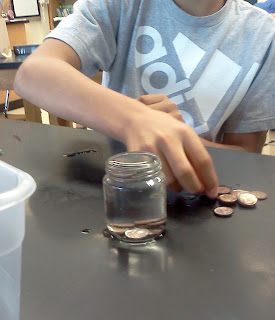Procedure A looked at the effect of temperature on the digestion of lipids.
Each test tube contained a pH indicator (that turns pink at a pH above 8), Olive Oil (a lipid), and a mixture of digestive enzymes. Initial observations were the same for both tubes
One tube was placed at room temperature while the other was placed at body temperature (in an incubator) and set overnight.
Here were final observations
Procedure B also was testing the effect of temperature on enzyme action but this time it looked at enzyme activity on Starch.
Each test tube had a starch solution, a mixture of digestive enzymes, and an iodine solution. The iodine solution turns a dark blue/black in the presence of starch. Here is how all three started.
 |
| Test tube 1 placed at 5 degrees Celcius, 2 kept at room temp and 3 placed in the incubator at 37 degrees Celcius (body Temp) |
 |
| You can see that the one placed in ice is still a dark blue color while the room temperature is a very pale blue and the body temperature one is completely clear (meaning there is NO starch left!!) |
And finally we had procedure C which looked at the effect of pH on enzyme activity. In this case we looked at enzymes activity on proteins.
Each test tube received a piece of boiled egg white and pepsin (a proteolytic enzyme). The changing variable in this case was the pH. One test tube had an acid added to it (Hydrochloric acid), The second had pure water (neutral pH) and the third had a base added to it (sodium hydroxide)
 |
| Set up |
The constant variable here was the temperature. ALL of them made their way into the incubator to work at body temperature over night.
And here were final observations. The protein which was placed in an acidic environment (like that of our stomachs) worked the best and completely digested the egg. The one at a fairly neutral pH did not do much at all while the basic test tube had slight enzyme activity.
We will continue to draw conclusions about enzyme activity on Monday!!!





































